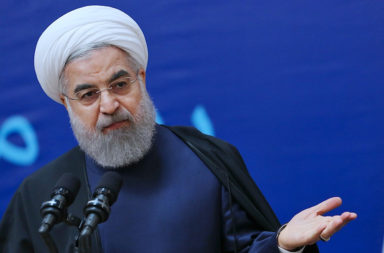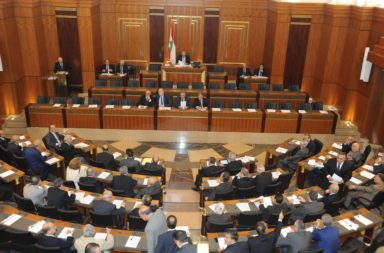The Iranian nuclear deal’s Implementation Day arrived this weekend in the shadow of Tehran’s repeated efforts to humiliate the United States — and the portent of further aggression to come. The long-awaited milestone, which marks the completion of Tehran’s initial steps to curtail key parts of its nuclear program, restores Iran’s access to some $100 billion in frozen assets, which the regime can now use to expand its drive for regional supremacy. Tehran’s latest provocations, including its use of American hostages as bargaining chips, its capture of U.S. sailors in the Persian Gulf, and its illicit ballistic missile tests, aim to convey a simple message: In the post nuclear-deal era, Iran’s hostility toward the West not only will endure, but will intensify.
The Prisoner Swap and Iran’s Ballistic Missile Tests
While the safe return of U.S. hostages from Iran’s notorious prisons should elicit relief, their freedom comes at a price that ultimately serves to encourage future belligerence. In exchange for innocent Americans incarcerated on trumped-up charges, including Washington Post reporter Jason Rezaian, U.S. Marine veteran Amir Hekmati, Idaho pastor Saeed Abedini, and previously undisclosed prisoner Nosratollah Khosravi-Roodsari, the Obama administration released seven Iranians who violated sanctions on Tehran’s nuclear or military program. (Iran released another previously undisclosed prisoner, Matthew Trevithick, separately.) The White House also dismissed charges against 14 other Iranians it had sought to arrest, including two men who helped transfer soldiers and weapons to Syria’s Assad regime and the Lebanese terrorist group Hezbollah.
Such a trade hardly constitutes a “reciprocal humanitarian gesture,” as President Obama claimed. In fact, the swap effectively invites Iran to capture more U.S. hostages in order to engage in further extortion. Tehran already probably recognizes such potential: The exchange notably failed to secure the release of another prisoner, Siamak Namazi, whom Iran likely retained to serve as a future bargaining chip for concessions it failed to obtain as part of the present exchange. Moreover, the United States acquired no new information about the location of former FBI agent Robert Levinson, who went missing in Iran in 2007 and may be languishing in an Iranian prison.
Equally troubling, as Bloomberg View’s Josh Rogin has noted, is the pardon of two Iranian patrons of Damascus and Hezbollah, which serves to enflame and prolong Syria’s bloody civil war. Hamid Arabnejad and Gholamreza Mahmoudi, senior officials at Iran’s privately owned Mahan Air, have long utilized the airline to transfer soldiers and arms to the Syrian battlefield — and may now continue their efforts with impunity. The clemency not only contradicts President Obama’s claim that the nuclear deal has spurred Iranian cooperation on other issues, but also undermines his pledge to continue sanctions on Iran’s support for terrorism after the nuclear deal.
In this context, new reports have emerged that an Iranian threat to torpedo the exchange of prisoners accounted for the Obama administration’s humiliating December 30 reversal — only hours after it had notified Congress — of its plan to impose new financial sanctions for Iran’s illicit ballistic missile tests in October and November. The Treasury Department finally announced the sanctions on Sunday, prompting an unrepentant Iran to respond that it will now continue its ballistic missile program “more seriously.” Tehran’s defiance likely stems not only from the relative insignificance of the penalties, which pale in comparison to the billions of dollars in nuclear-related sanctions relief that Implementation Day has bestowed, but also from its confidence that it still possesses the leverage necessary to engage in more extortion in the future.
Iran’s Naval Aggression
The capture of 10 U.S. Navy sailors in the Persian Gulf last week — just hours before President Obama’s State of the Union address and days before Implementation Day — further signaled Tehran’s continued hostility toward America. The regime’s release of video footage of the sailors’ surrender, as well as a video of one sailor issuing an apology, sought to transmit the message that Iran still considers the United States its enemy.
The incident, said Maj. Gen. Hassan Firouzabadi, chair of Iran’s Armed Forces General Staff, “demonstrated the awareness and precision of the Iranian armed forces regarding American movements in the region. It taught them how vulnerable they are against the Islamic Republic’s mighty forces.” Brig. Gen. Hossein Salami, deputy commander of the Islamic Revolutionary Guard Corps (IRGC), expressed similar sentiments. “No country in the world has been able to detain an American soldier since World War II,” he gloated. “Yet when these soldiers entered our waters, small Iranian vessels … surrounded and arrested them. These ten sailors surrendered to five or six young IRGC members.”
The episode followed a similar act of Iranian naval aggression less than three weeks earlier. On December 26, Iran test-fired rockets near the USS Harry S. Truman, an American aircraft carrier, almost triggering an international crisis. “These actions were highly provocative, unsafe, and unprofessional and call into question Iran’s commitment to the security of a waterway vital to international commerce,” said Navy Commander Kyle Raines, spokesman for the U.S. Central Command. Nevertheless, the United States apparently did nothing in response.
These developments carry powerful symbolism. By trumpeting America’s weakness and inaction, Iran seeks to demonstrate that the Obama administration lacks the ability to alter the Islamist regime’s ideology or ambitions, and that the United States constitutes a paper tiger that cannot or will not stand up for its own honor or interests. Similarly, Iran’s behavior raises a disturbing question: If Iran remains willing to provoke the United States before it has received sanctions relief, why would it hesitate to provoke America even more dramatically after its reentry into the international economy on Implementation Day?
The White House in Denial
In a statement on Sunday, President Obama portrayed the prisoner exchange and Iran’s release of U.S. sailors as triumphs of American diplomacy that illustrate the positive impact of the nuclear agreement. The deal, he argued, “created a unique opportunity — a window — to try to resolve important issues” unrelated to the nuclear file. “I am hopeful,” he added, “that this signals the opportunity at least for Iran to work more cooperatively with nations around the world to advance their interests and the interests of people who are looking for peace and security for their families.”
Echoing a March 2009 speech that launched his presidency’s public diplomacy with Iran, Obama also addressed the Iranian people directly. “Yours is a great civilization,” he said, “with a vibrant culture that has so much to contribute to the world — in commerce, and in science and the arts.” Because of the nuclear deal, he asserted, “We have a rare chance to pursue a new path — a different, better future that delivers progress for both our peoples and the wider world. That’s the opportunity before the Iranian people. We need to take advantage of that.”
Iran’s recent behavior, however, suggests that such an opportunity remains more elusive than ever. The prisoner swap indicates not that Iran has suddenly moderated its view of the United States, but that the regime, in the post-nuclear deal era, considers U.S. hostages useful for advancing strategic objectives. Tehran’s release of U.S. sailors suggest not that U.S.-Iranian diplomacy has progressed, but that Iran, in the post-nuclear deal era, still believes that it can abduct U.S. sailors with impunity. Both episodes thus reflect not a vindication of the nuclear deal, but a warning of things to come.
In this context, President Obama’s direct attempt to elicit the support of the Iranian people misreads the political reality. In 2016, as in 2009, Iran remains a theocratic dictatorship. Yet today, the Islamist regime arguably possesses even greater power and resources than it has in the past. With billions of dollars in sanctions relief, Iran can strengthen its military, bolster its regional proxies, expand its control of key sectors of Iran’s economy, and further solidify its grip on power.
In fact, in the six months since the nuclear agreement, Tehran — eager to demonstrate that the deal will not produce a more moderate government — has already executed the largest human rights crackdown since the Green Revolution of 2009. Moreover, the regime recently disqualified thousands of reformist candidates seeking greater political and economic freedom from running in Iran’s upcoming parliamentary elections. Thus, because of the deal, a repressive regime has become even more repressive, leaving the Iranian people in a weaker position to influence its government’s policies.
Conclusion
Implementation Day marks a grim milestone in the annals of U.S.-Iranian relations. Yet its significance lies not merely in its economic empowerment of one of the world’s leading state sponsors of terrorism, but also in the Obama administration’s inability to recognize the multiple warning signs that have preceded it. “We seek the promise of a new beginning,” President Obama said in March 2009. Seven years later, he undoubtedly has achieved one — if not the beginning he perceives or expects.




